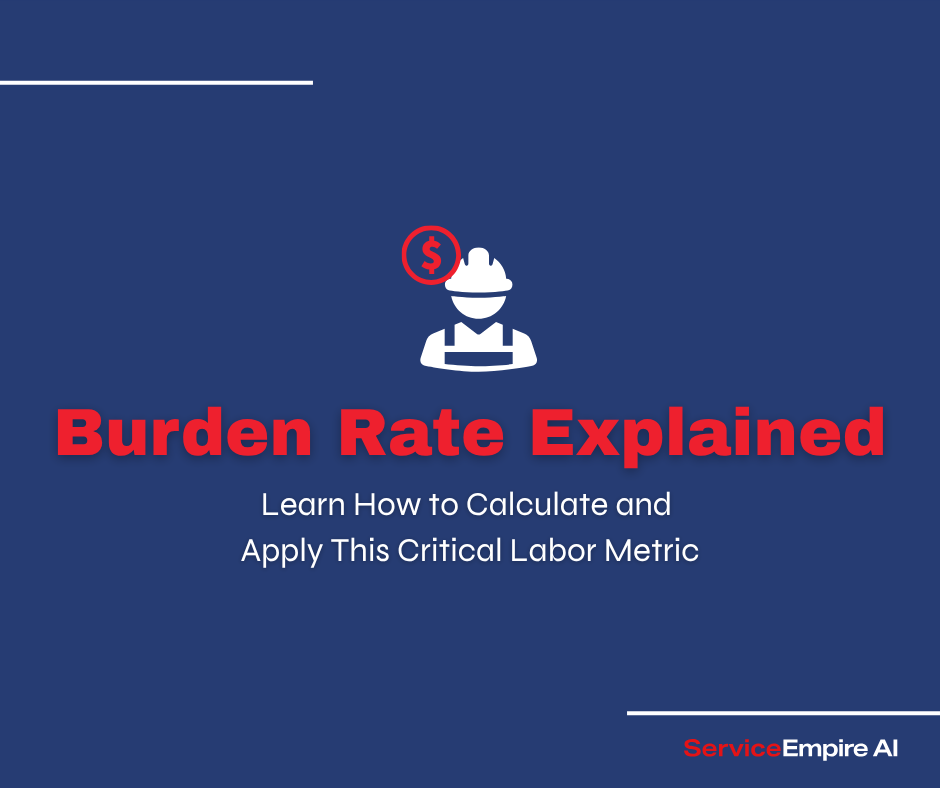
How much does a $50,000 employee cost your business? The answer is NOT $50,000! Small to medium businesses underestimate their true labor costs by 15-30%, according to numerous sources. This widespread misconception creates a dangerous blind spot in financial planning that silently erodes profitability.
While most business owners and managers track base wages and salaries meticulously, they often fail to account for the substantial additional costs associated with employment—the burden rate.
The burden rate encompasses all costs beyond base compensation that a company incurs when employing someone, including taxes, insurance, benefits, and various overhead expenses. This critical financial metric reveals the true cost of labor, which typically ranges from 125% to 180% of base wages. Understanding your organization's specific burden rate is essential for accurate project bidding, proper pricing, informed hiring decisions, and ultimately, your business’s profitability.
This comprehensive guide will walk you through everything you need to know about burden rate—from fundamental definitions to calculation methods, industry benchmarks, and strategic applications. You’ll be equipped with the knowledge to make more informed hiring and firing decisions.
What Is Burden Rate? Definition and Basics
The burden rate represents the additional employment costs beyond base wages or salaries that a business incurs for each employee. It provides a more complete picture of labor costs by accounting for mandatory taxes, insurance, benefits, and other expenses directly tied to employment.
Core Definition
In accounting and financial management, the burden rate (sometimes called the labor burden rate) is typically expressed as either:
- A percentage of direct labor costs (e.g., a 45% burden rate means additional costs equal 45% of base wages)
- A dollar amount per hour (e.g., $15/hour burden on top of a $30/hour base wage)
The concept acknowledges that an employee earning $50,000 in annual salary actually costs the company significantly more—often $70,000 to $90,000 when all employment-related expenses are considered.
Key Distinctions
Two primary components make up the overall burden.
Payroll Burden: Expenses directly tied to compensation, including:
- Employer payroll taxes
- Workers' compensation insurance
- Health insurance and benefits
- Retirement contributions
- Paid time off
- Other direct employee benefits
Overhead Burden: Additional costs associated with supporting employees, including:
- Workspace and facilities
- Equipment and technology
- Administrative support
- Training and development
- Compliance costs
- Management and supervision
Historical Context
The burden rate concept emerged as businesses evolved beyond simple owner-operator models to more complex organizations with employees. The accounting principle stems from the need to properly allocate all labor-related costs to products, services, or projects to determine true profitability.
Critical Importance
Understanding burden rate is particularly crucial in:
- Labor-intensive industries (construction, professional services, healthcare)
- Project-based businesses that bid or estimate work
- Government contracting with strict cost accounting requirements
- Manufacturing operations with complex cost structures
- Service businesses where labor is the primary cost driver
Without a properly calculated burden rate, businesses risk:
- Underbidding projects
- Underpricing services
- Making poor outsourcing decisions
- Misallocating resources
- Creating inaccurate financial projections
Components of Burden Rate
The burden rate consists of numerous cost elements that vary by industry, company size, location, and compensation structure. Understanding these components is essential for accurate calculation.
Mandatory Payroll Taxes
These government-required expenses are unavoidable for employers:
- Social Security and Medicare (FICA): Employers match employee contributions (7.65% of wages up to annual limits)
- Federal Unemployment (FUTA): Generally 0.6% on the first $7,000 of each employee's wages
- State Unemployment (SUTA): Varies by state and experience rating (typically 2-5% on a wage base ranging from $7,000 to $52,700)
- State-specific taxes: Some states have additional employment taxes (e.g., disability insurance)
Insurance Costs
These include both mandatory and optional insurance programs:
- Workers' Compensation: Required in most states, rates vary significantly by industry risk classification (0.3% to 15%+ of payroll)
- Health Insurance: A major expense for many employers (average annual cost of $7,000-$22,000 per employee depending on coverage)
- Disability Insurance: Short and long-term coverage protecting against income loss
- Life Insurance: Often provided as an employee benefit
- Other specialized insurance: Professional liability, E&O coverage, etc.
Employee Benefits
These discretionary but often competitive-necessity benefits include:
- Retirement Plans: Matching contributions to 401(k) or similar plans (typically 3-6% of salary)
- Paid Time Off: Vacation, sick leave, holidays (representing 8-12% of annual work hours)
- Family Leave: Maternity, paternity, and family medical leave
- Tuition Assistance: Education support and reimbursement
- Wellness Programs: Health initiatives and incentives
- Other Fringe Benefits: Transportation allowances, meals, etc.
Facilities and Equipment
Physical space and tools required for employees:
- Workspace: Office space, production areas, storage (typically calculated as square footage per employee)
- Utilities: Electricity, water, climate control, internet
- Furniture and Fixtures: Desks, chairs, storage, equipment
- Technology: Computers, phones, software, and licensing
- Supplies: Office materials, consumables, and other resources
Typical Component Ranges
While specific percentages vary, here's a general breakdown of burden rate components:
Burden Rate vs. Other Cost Metrics
The burden rate is one of several related but distinct cost allocation concepts that organizations use. Understanding the differences helps apply the right metric in the right context.
Burden Rate vs. Overhead Rate
While sometimes used interchangeably, these terms have important distinctions:
Burden Rate focuses specifically on additional costs associated with employing people—the "burden" of employment beyond wages and salaries.
Overhead Rate encompasses all indirect business costs regardless of whether they're employee-related, including rent, utilities, administrative expenses, marketing, and other operational costs.
A manufacturing company might track both: burden rate for accurate labor costing and overhead rate for allocating shared business costs to different product lines.
Burden Rate vs. Fringe Benefits Rate
Fringe Benefits Rate is a narrower metric focusing exclusively on employee benefits (health insurance, retirement, paid time off), excluding taxes and overhead allocations.
This rate is commonly used in government contracting, where fringe benefits may be calculated and billed separately from other burden components.
Burden Rate vs. Fully Loaded Cost
Fully Loaded Cost represents the total cost of an employee, including base compensation plus all burden components.
If an employee earns $25/hour with a 40% burden rate, their fully loaded cost would be $35/hour ($25 + $10 burden).
Comparison of Cost Metrics
The Burden Rate Formula and Calculation
Calculating your organization's burden rate requires a systematic approach to identify and allocate all relevant costs.
Basic Burden Rate Formula
The standard formula for calculating burden rate as a percentage:
Burden Rate (%) = (Total Additional Employment Costs ÷ Total Base Wages and Salaries) × 100
Alternatively, for an hourly burden rate:
Hourly Burden Rate ($) = Total Additional Employment Costs ÷ Total Billable Hours
Step-by-Step Calculation Process
- Identify the calculation period: Typically a fiscal year, but could be quarterly for volatile businesses.
- Determine total base wages and salaries: Sum all direct compensation paid to employees during the period.
- Compile all payroll taxes paid:
- FICA (Social Security and Medicare)
- Federal and state unemployment
- Other employment taxes
- Calculate all benefit costs:
- Health, life, and disability insurance premiums
- Retirement contributions
- Paid time off value (convert to dollars)
- Other benefit program costs
- Include additional employment-related overhead:
- Workspace costs (allocated per employee)
- Equipment and technology
- Training and development
- Other employee-specific overhead
- Sum all additional costs: Total all costs beyond base compensation.
- Divide by the appropriate base: Either total compensation or total work hours.
- Convert to percentage or hourly rate: Express as needed for your application.
Example Calculation
For a company with:
- Annual payroll: $1,000,000
- Payroll taxes: $90,000
- Insurance: $150,000
- Benefits: $120,000
- Employment-related overhead: $240,000
Total Additional Costs = $90,000 + $150,000 + $120,000 + $240,000 = $600,000
Burden Rate = ($600,000 ÷ $1,000,000) × 100 = 60%
This company's burden rate is 60%, meaning for every $1.00 in base wages, they spend an additional $0.60 in related costs.
Department-Specific vs. Company-Wide Rates
Many organizations benefit from calculating separate burden rates for:
- Different departments (IT vs. Manufacturing)
- Various job categories (Administrative vs. Technical)
- Employment types (Full-time vs. Part-time)
This granularity enables more accurate costing and better decision-making but increases calculation complexity.
Calculating Payroll Burden Rate
The payroll burden rate focuses specifically on the additional costs directly tied to compensation, excluding general overhead allocations.
Payroll Tax Calculations
Calculate the employer's share of:
- Social Security: 6.2% of wages up to the annual limit ($147,000 in 2022)
- Medicare: 1.45% of all wages (plus 0.9% Additional Medicare Tax on wages over $200,000)
- FUTA: Generally 0.6% on first $7,000 of wages
- SUTA: Varies by state and experience rating
Benefits Cost Allocation
Properly allocate benefit costs:
- Insurance Premiums: Divide total employer premium costs by total payroll
- Retirement Matching: Calculate as a percentage of eligible compensation
- Bonuses and Incentives: Include in additional employment costs
Paid Time Off Calculation
PTO is an often overlooked burden component:
- Calculate total PTO hours (vacation + sick + holidays)
- Divide by total work hours to find percentage of compensated non-productive time
- Alternatively, divide total PTO cost by total productive labor cost
For example, an employee with 25 PTO days (200 hours) out of 260 work days (2,080 hours) has:
PTO Percentage = (200 ÷ 2,080) × 100 = 9.6%
This means 9.6% of compensation goes toward paid non-productive time. This amount of time off is common in the public sector, not so much in the private sector.
Payroll Burden Calculation Example
For an employee earning $50,000 annually:
Payroll Burden Rate = ($19,592 ÷ $50,000) × 100 = 39.2%
Industry-Specific Burden Rate Considerations
Burden rates vary across industries due to different regulatory requirements, benefit standards, risk profiles, and operational models.
Construction Industry
Construction typically has high burden rates (50-100%+) due to:
- Elevated workers' compensation rates (high-risk activities)
- Multiple union requirements and contributions
- Multi-state compliance issues
- Seasonal employment patterns
- Specialized training and certification needs
Construction firms often calculate burden separately for different trades (electrical, plumbing, carpentry) due to varying risk classifications and pay scales.
Manufacturing Sector
Manufacturing burden rates (40-70%) are influenced by:
- Shift differential considerations
- Specialized safety equipment and training
- Union contracts and obligations
- Skill development and certification programs
- Machinery and workspace requirements
Many manufacturers separate production worker burden from administrative staff burden to improve product costing accuracy.
Professional Services
Professional service firms experience burden rates of 30-60% with considerations including:
- High benefit expectations for skilled professionals
- Significant technology and software costs
- Continuous professional development requirements
- Premium office space and amenities
- Lower workers' compensation but higher professional liability insurance
Law firms, engineering companies, and consulting firms typically include non-billable time in burden calculations to ensure accurate client billing rates.
Healthcare Organizations
Healthcare providers face unique burden factors (45-80%):
- Clinical liability insurance costs
- Licensing and continuing education requirements
- Infection control and safety protocols
- 24/7 staffing considerations
- Regulatory compliance costs
Many healthcare organizations calculate separate rates for clinical vs. administrative staff.
Industry Benchmark Ranges
While specific to each organization, industry benchmarks provide useful reference points:
Burden Rate in Project Estimation and Bidding
Having an accurate burden rate is crucial for competitive yet profitable project bidding.
Project Labor Cost Estimation
Follow these steps to incorporate burden rate:
- Estimate direct labor hours required for each project phase
- Multiply hours by appropriate hourly wage rates
- Apply the burden rate to determine total labor cost
- Include additional project-specific expenses
- Add markup for profit
Burden Rate for Different Employee Types
Full-Time vs. Part-Time Employees
Full-time employees typically have higher burden rates (40-60%) due to:
- Comprehensive benefits eligibility
- Higher paid time off accruals
- Retirement plan participation
- Full health insurance coverage
Part-time employees generally have lower rates (20-35%) because:
- Many benefits are reduced or unavailable
- Insurance costs may be proportionally lower or nonexistent
- Paid time off is often limited
- Some overhead costs remain similar regardless of hours worked
Hourly vs. Salaried Staff
Hourly employees (non-exempt) have burden considerations including:
- Overtime premium pay requirements
- Potential seasonal variations
- More variable schedules
Salaried employees (exempt) often include:
- Higher benefit expectations
- More substantial PTO allowances
- Professional development investments
Remote Worker Considerations
Remote work arrangements affect certain burden components:
- Reduced facility costs (potentially 50-80% lower)
- Increased technology expenditures
- Different state tax obligations
- Unique insurance considerations
- Home office stipends or allowances
Common Mistakes in Burden Rate Calculation
Avoiding these common errors ensures more accurate burden rate calculations:
Overlooking Hidden Costs
Many organizations fail to include:
- Administrative costs for managing benefits
- Recruitment and onboarding expenses
- Employee assistance programs
- Training time and materials
- Compliance and reporting costs
Improper Time Period Alignment
Ensure all calculations use consistent time periods:
- Match tax rates to the appropriate year
- Align benefit costs with the calculation period
- Account for mid-year program changes
- Consider seasonal variations in certain expenses
Using Outdated Information
Burden components change regularly due to:
- Annual tax rate and wage base adjustments
- Insurance premium changes
- Benefit program modifications
- Regulatory requirement updates
Recalculate burden rates at least annually, and update when significant changes occur. Of course, the other major metric to watch: your turnover costs. Read this article to learn how to reduce employee turnover.
Overgeneralizing Across Departments
Different departments often have substantially different burden profiles due to:
- Varying compensation structures
- Different risk classifications
- Specialized equipment needs
- Unique space requirements
- Distinct skill development needs
Using Burden Rate in Financial Decision Making
Understanding burden rate improves numerous business decisions.
Hiring Decisions
When evaluating additional headcount, consider:
- Full cost including burden, not just salary
- Alternative staffing approaches (part-time, contractors)
- Cost of overtime for existing staff vs. new hires
- Long-term burden trend projections
Outsourcing Evaluation
Compare fully burdened internal costs to outsourcing options:
- Calculate total in-house cost (base + burden)
- Consider quality, control, and flexibility factors
- Evaluate long-term cost trajectory
- Assess hidden costs of vendor management
Pricing Strategy Development
Set service rates that ensure profitability by:
- Including fully burdened labor costs
- Adding appropriate overhead allocation
- Incorporating target profit margin
- Adjusting for market competitiveness
Budgeting Applications
Create more accurate budgets by:
- Forecasting full employment costs, not just base compensation
- Adjusting for anticipated benefit changes
- Accounting for burden rate seasonality
- Planning for regulatory requirement changes
Conclusion
The burden rate stands as one of the most critical yet frequently overlooked financial metrics in business management. By capturing the full cost of employment beyond base wages and salaries, burden rate calculations illuminate the true cost of labor—often 1.3 to 1.8 times the base compensation amount.
Organizations that master burden rate calculation gain a significant competitive advantage through more accurate project bidding, proper service pricing, informed hiring decisions, and realistic financial planning. Conversely, those that ignore or improperly calculate their burden rate risk systematic underpricing, inaccurate budgeting, and gradually eroding profitability.
For maximum business impact, establish a regular burden rate calculation process, create appropriate granularity with department or position-specific rates where needed, and integrate burden rate awareness into all labor-related decision-making. With this approach, the burden rate transforms from an accounting exercise into a powerful strategic tool for building sustainable business success.
FAQ Section
What is a typical burden rate percentage?
Burden rates typically range from 25% to 80% of base wages, varying significantly by industry, location, company size, and compensation structure. Labor-intensive industries with high risk profiles (construction, manufacturing) tend toward the higher end (50-80%), while service industries with fewer benefits and lower risk classifications might range from 25-45%. Professional service firms with comprehensive benefits but low physical risk typically fall in the 30-60% range. Rather than relying on industry averages, organizations should calculate their specific burden rate based on their unique cost structure.
How often should burden rate be recalculated?
Most businesses should recalculate their burden rate annually at minimum, typically aligned with the fiscal year or budget planning cycle. However, several situations warrant immediate recalculation: significant benefit program changes, insurance premium adjustments, tax rate modifications, major shifts in staffing composition, or substantial changes to workspace allocation. Organizations experiencing rapid growth or with highly seasonal operations may benefit from quarterly recalculations to maintain accuracy. The key is ensuring your rate reflects current costs rather than historical figures that may no longer apply.
Should different departments have different burden rates?
Yes, using department-specific burden rates often provides greater accuracy, especially when departments have substantially different cost profiles. For example, a manufacturing department might have higher workers' compensation costs but fewer technology expenses than an administrative department. Similarly, a sales team might have lower facility costs if primarily field-based but higher travel and mobile technology expenses. Department-specific rates are particularly valuable for organizations that: 1) use cost-plus pricing models, 2) need accurate departmental profitability analysis, or 3) make frequent make-vs-buy decisions. However, this approach requires more sophisticated accounting systems and processes.
Is burden rate the same as markup?
No, burden rate and markup are distinct concepts, though they're sometimes confused. Burden rate represents the additional employment costs beyond base wages as a percentage of those wages—a cost accounting concept for understanding true labor expenses. Markup, conversely, is the percentage added to costs to arrive at a selling price—a pricing strategy concept for ensuring profitability. While burden rate helps determine true costs, markup helps establish appropriate pricing after all costs (including burdened labor) are calculated. Both are essential financial concepts, but they serve different purposes in business management and financial analysis.






